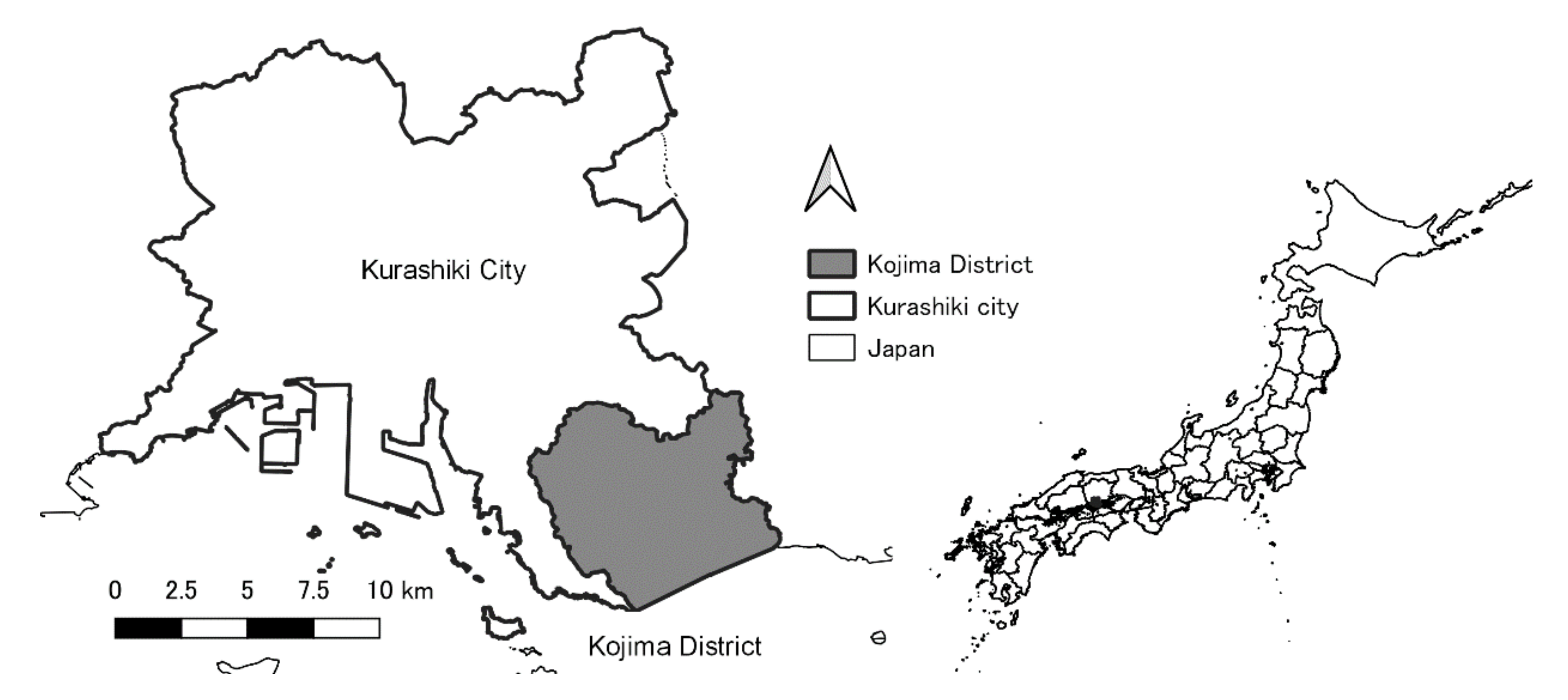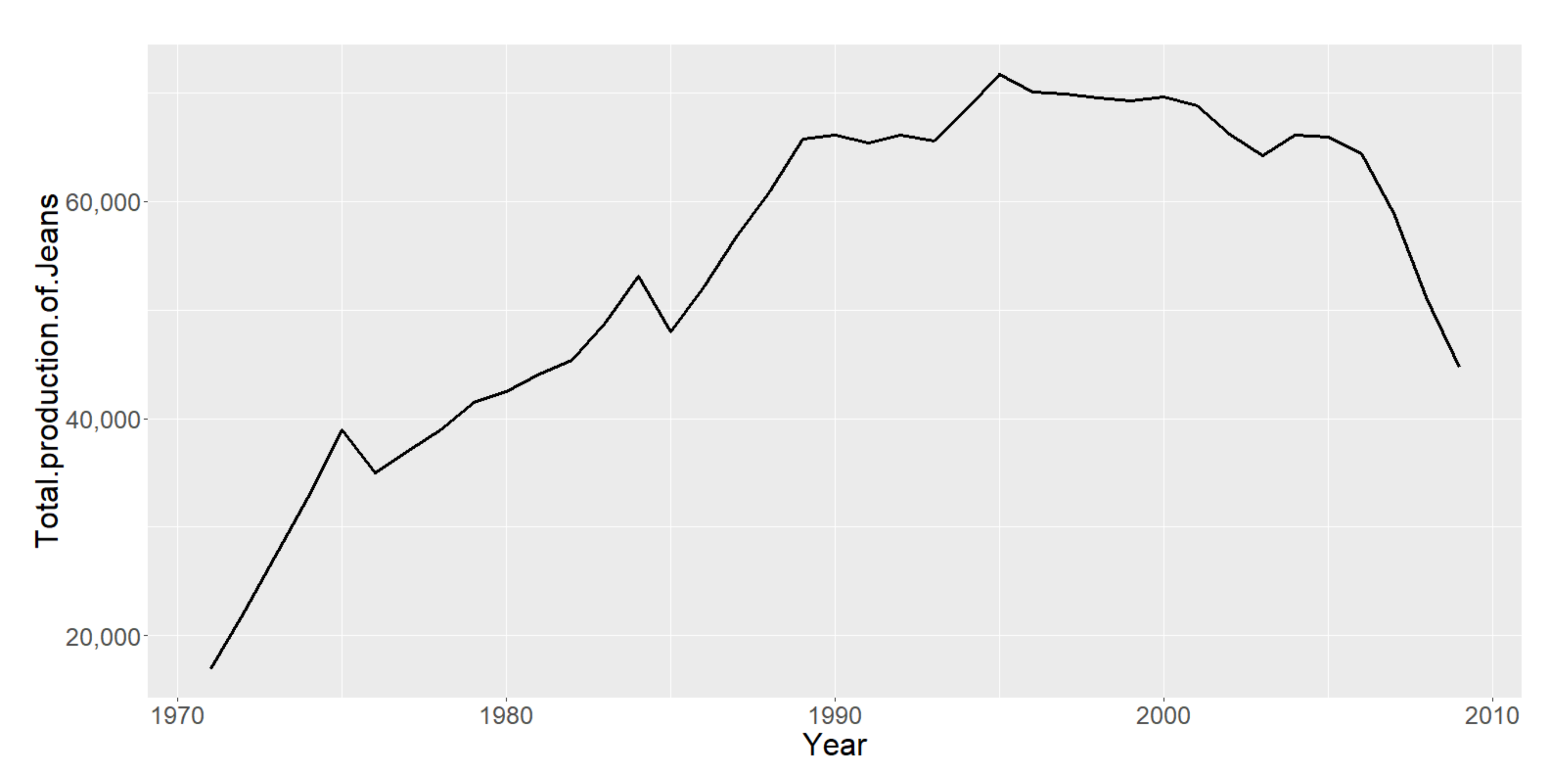Applying Storytelling Approach to Analyze Kojima Jeans District Based on Slow Fashion Perspectives
Abstract
:1. Introduction
2. Related Literatures
2.1. Business Strategies
2.2. Community-Based Fashion Business
3. Methods
3.1. A Storytelling Method
3.2. Analytical Framework
3.3. Data Collection
4. General Overviews of Kojima District in Okayama Prefecture
Kojima District
5. Case Study of the Kojima Jeans District
5.1. Transformation of Major Industries in Kojima District
5.2. The Multifiber Arrangement (MFA) and Shifting High-Quality Jeans Productions
5.3. Emergence of Urban Sprawling Versus Development of the Kojima Jeans Street
5.4. Achievements of Kojima Jeans Street
6. Results and Discussion
6.1. The Perspective of Localism
6.2. The Perspective of Quality
6.3. The Perspective of Values
7. Conclusions
Funding
Institutional Review Board Statement
Informed Consent Statement
Data Availability Statement
Acknowledgments
Conflicts of Interest
References
- Liu, C.; Xia, S.; Lang, C. Clothing Consumption during the COVID-19 Pandemic: Evidence from mining tweets. Cloth. Text. Res. J. 2021, 39, 1–17. [Google Scholar] [CrossRef]
- Lanvin, B. The World’s Most Innovative Countries. 2021. Available online: https://knowledge.insead.edu/entrepreneurship/the-worlds-most-innovative-countries-2021-17401 (accessed on 9 December 2021).
- Fletcher, K. Slow Fashion: An invitation of systems change. Fash. Pract. 2007, 2, 259–266. [Google Scholar] [CrossRef]
- Stefko, R.; Steffek, V. Key Issues in Slow Fashion: Current Challenges and Future Perspectives. Sustainability 2018, 10, 2270. [Google Scholar] [CrossRef] [Green Version]
- Jun, S.; Jin, B. Sustainable Development of Slow Fashion Businesses: Customer Value Approach. Sustainability 2016, 8, 540. [Google Scholar]
- Clark, H. Slow + Fashion—An oxymoron—Or a promise for the future. Fash. Theory 2008, 12, 427–446. [Google Scholar] [CrossRef]
- Pookulangara, S.; Shephard, A. Slow fashion movement: Understanding consumer perceptions—An exploratory study. J. Retail. Consum. Serv. 2013, 20, 200–206. [Google Scholar] [CrossRef]
- Secinaro, S.; Calandra, D.; Biancone, P.P. Reflection on Coronavirus Accounting Impact on Small and Medium Sized Enterprises (SMEs) in Europe. Int. J. Bus. Manag. 2020, 15, 48–56. [Google Scholar] [CrossRef]
- Poter, E.M. Competitive Strategy: Techniques for Analyzing Industries and Competitors; Free Press: New York, NY, USA, 2008. [Google Scholar]
- Magretta, J. Understanding Michael Porter: The Essential Guide to Competition and Strategy; Harvard Business Press: Boston, MA, USA, 2012. [Google Scholar]
- Kotler, P.; Keller, L.K. A Framework for Marketing Management, 6th ed.; eBook; Pearson: San Antonio, TX, USA, 2016. [Google Scholar]
- Chan, K.; Mauborgne, R. Blue Ocean Strategy: How to Create Uncontested Market Space and Make the Competition Irrelevant; Harvard Business School Publishing Corporation: Watertoen, MA, USA, 2004. [Google Scholar]
- Wubben, E.; Dusseldorf, S.; Batterink, H.M. Finding uncontested markets for European fruit and vegetables through applying the Blue Ocean Strategy. Br. Food J. 2012, 114, 248–271. [Google Scholar] [CrossRef]
- Trejo, H. Exploring the New York Slow Fashion Value Chain: Local Animals, Fibers, and Knit Wear. A Thesis Presented to the Faculty of the Graduate School of Cornell Yniversity in Partial Fulfillment of the Requirements for the Degree of Master of Arts. Available online: https://ecommons.cornell.edu/handle/1813/38988 (accessed on 9 December 2021).
- California Fibershed Cooperative. 2017. Available online: https://norcalfibershedcoop.com/ (accessed on 9 December 2021).
- Trejo, X.H.; Smith, A.G.; Trejo, K.N.; Lewis, L.T. Made in New York: A collaborative model to encourage slow fashion. Cloth. Text. Res. J. 2019, 37, 1–16. [Google Scholar] [CrossRef]
- Fletcher, K. The fashion land ethic: Localism, clothing activity, and Macclesfield. J. Des. Creat. Process Fash. Ind. 2018, 10, 139–159. [Google Scholar] [CrossRef]
- Brydges, T. “Made in Canada”: Local production networks in the Canadian fashion industry. Can. Geogr. 2018, 62, 238–249. [Google Scholar] [CrossRef]
- Magretta, J. Why Business Models Matter. Harv. Bus. Rev. 2002, 80, 86–92. [Google Scholar] [PubMed]
- Aaker, D. Creating Signature Stories: Strategic Messaging That Persuades, Energizes and Inspires; Morgan James Publishing: New York, NY, USA, 2018. [Google Scholar]
- Oxford Advanced Learner’s Dictionary; University Press: Cambridge, UK, 2000.
- Kurashiki City. Available online: https://www.city.kurashiki.okayama.jp/ (accessed on 9 December 2021).
- Enari, Y.; Hiraoka, K.; Ishikawa, I.; Kosugi, R.; Yano, H.; Okamochi, K.; Zhang, A.; Xia, X.; Li, W.; Tang, Z.; et al. Current Conditions and Issues of the Textile Industry in Kojima Area, Kurashiki City: A Case Study of Kojima Jeans Street. Policy Sci. 2019, 26, 131–143. (In Japanese) [Google Scholar]
- Becker, S. Empire of Cotton: A Global History; Vintage Books: New York, NY, USA, 2014. [Google Scholar]
- Nagata, S. Changes in textile industrial agglomeration under globalization: A case study of the denim jeans district. Proc. Fukuoka Prefect. Univ. 2012, 21, 103–113. [Google Scholar]
- Sugiyama, S. Nihon Jeans Monogatari: Innovation to Shigen Baseriron Karano Kyousouyuuisei; Kibito Shuppan: Okayama, Japan, 2009. [Google Scholar]
- Keet, P. Making New Vintage Jeans in Japan: Relocating Authenticity. Textile 2011, 9, 44–61. [Google Scholar] [CrossRef]
- Fujioka, R.; Wubs, B. Competitiveness of the Japanese Denim and Jeans Industry: The Cases of Kaihara and Japan Blue, 1970–2015. In European Fashion: The Creation of a Global Industry; Blaszczyk, R.L., Pouillard, V., Eds.; Manchester University Press: Manchester, UK, 2020. [Google Scholar]
- Saeki, A. In a History Nihon No Jeans; Nihon Seni Shinbunsha: Tokyo, Japan, 2006; pp. 26–39. [Google Scholar]
- Kubooka, N.; Kouga, I.; Akira, S.; Sakurai, H.; Nishikawa, T.; Nishiyama, M.; Yoshimura, T. Jeans Handbook, 9th ed.; Seni Ryutsu Kennkyukai: Tokyo, Japan, 2010. [Google Scholar]
- Aggarwal, V.K. The unraveling of the Multifiber arrangement, 1981: An examination of international regime change. Int. Organ. 1983, 37, 617–645. [Google Scholar] [CrossRef]
- MacDonald, S. The Workd Bids Farewell to the Multifiber Arrangement. Amber Waves 2006, 4, 20–25. [Google Scholar]
- Ogawa, T. Dictionary of Fashion/Apparel; Senken Shinbunsha: Tokyo, Japan, 2013; pp. 455–456. [Google Scholar]
- Kurashiki Fashion Center. Jeans Sommelier Shikakuninteishiken Koushiki Text; Okayama Prefecture Apparel Industrial Association: Kurashiki, Japan, 2013. [Google Scholar]
- Kimura, K.; (Japan Blue, Kojima, Japan). Personal Interview. 6 October 2021. [Google Scholar]
- Suesa, T. Kojima Jeans Street Koso: Chousen Jiba Sangyo wo Mochiita Chiikisaisei; Shoko Research Institute: Tokyo, Japan, 2016; Available online: https://www.shokosoken.or.jp/jyosei/soshiki/s28nen/s28-6.pdf (accessed on 9 December 2021). (In Japanese)
- Suesa, T.; (Kojima Chamber of Commerce, Kojima, Japan). Personal Interview. 6 October 2021. [Google Scholar]
- Snyder, R.L. Fugitive Denim; W. W. Norton & Co Inc.: New York, NY, USA, 2009. [Google Scholar]
- Hassink, R. How to unlock regional economies from path dependency? From learning region to learning cluster. Eur. Plan. Stud. 2005, 13, 521–535. [Google Scholar] [CrossRef]
- Manabe, T. Seni shuseki sanchi Kojima to Jeans no machizukuri. Ind. Locat. 2015, 54, 19–22. (In Japanese) [Google Scholar]




| Method | Target | |
|---|---|---|
| Magretta (2002) | Storytelling method | One business |
| This study | Expanded storytelling method | Community-based businesses |
| Period | Years | Main Products |
|---|---|---|
| Edo era | 1600s~1700s | cottons, salt |
| Meiji era Taisho era Beginning of Showa era | 1790s~1890s 1900s~1920s 1920s~1950s | Kasuri (cotton Kimonos) Tabi socks, Kimonos school uniform |
| Showa era | 1960s~1990s | jeans, school uniform |
| Heisei and Reiwa era | 2000s~ | high quality Jeans |
| Years | 2008 | 2009 | 2010 | 2011 | 2012 | 2013 | 2014 | 2015 | 2016 | 2017 | 2018 | 2019 | 2020 |
|---|---|---|---|---|---|---|---|---|---|---|---|---|---|
| Total Number | 4 | 5 | 10 | 14 | 18 | 24 | 31 | 34 | 36 | 40 | 42 | 44 | 46 |
| Increased shop | 0 | 1 | 5 | 4 | 4 | 6 | 7 | 3 | 2 | 4 | 2 | 2 | 2 |
| Closed shop | 0 | 0 | 0 | 0 | 0 | 0 | 0 | 0 | 0 | 1 | 0 | 0 | 2 |
| Relocated shop | 0 | 0 | 0 | 0 | 0 | 0 | 1 | 0 | 0 | 1 | 1 | 0 | 2 |
Publisher’s Note: MDPI stays neutral with regard to jurisdictional claims in published maps and institutional affiliations. |
© 2021 by the author. Licensee MDPI, Basel, Switzerland. This article is an open access article distributed under the terms and conditions of the Creative Commons Attribution (CC BY) license (https://creativecommons.org/licenses/by/4.0/).
Share and Cite
Nagano, A. Applying Storytelling Approach to Analyze Kojima Jeans District Based on Slow Fashion Perspectives. Sustainability 2021, 13, 13651. https://doi.org/10.3390/su132413651
Nagano A. Applying Storytelling Approach to Analyze Kojima Jeans District Based on Slow Fashion Perspectives. Sustainability. 2021; 13(24):13651. https://doi.org/10.3390/su132413651
Chicago/Turabian StyleNagano, Aki. 2021. "Applying Storytelling Approach to Analyze Kojima Jeans District Based on Slow Fashion Perspectives" Sustainability 13, no. 24: 13651. https://doi.org/10.3390/su132413651
APA StyleNagano, A. (2021). Applying Storytelling Approach to Analyze Kojima Jeans District Based on Slow Fashion Perspectives. Sustainability, 13(24), 13651. https://doi.org/10.3390/su132413651






